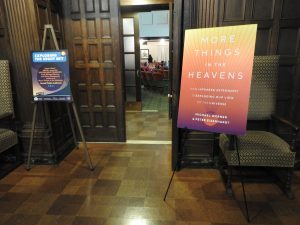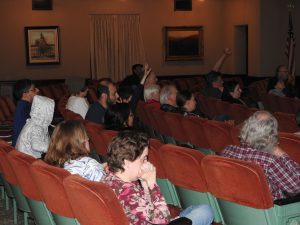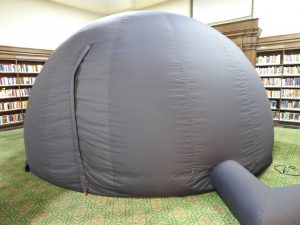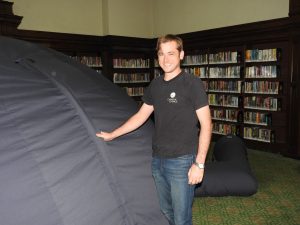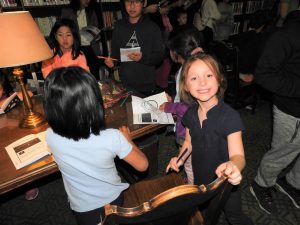
On Thursday, February 27, we had a special astronomy festival for the whole family! People of all ages got to learn something new and inspiring about the way our understanding of the universe has grown, and also the ways that you can help scientists track changes in night sky visibility.
Globe At Night Neighborhood Science Kit
When Los Angeles Public Library got a grant for bringing Neighborhood Science to other libraries, Pasadena was chosen as one of the first libraries to get their Neighborhood Science kits. There are currently five Neighborhood Science kits at Pasadena that you can check out and use to conduct observations and collect data that will help scientists understand more about the way our climate is changing, our air and water quality is changing, etc.
The Globe At Night kit includes a Sky Quality Meter for measuring the darkness in your area, and other tools and information. You can use a Sky Quality Meter to get a reading of the sky’s level of darkness, and then upload that reading to the databases that scientists are using to track changes. You can use either the Loss of the Night app (free, available for iPhones and Android phones) or the Globe at Night website for uploading your data.
Here is my slideshow with more information about the tools in our Globe at Night kit and how to use them:
Exploring the Universe with the Spitzer Space Telescope
Peter Eisenhardt and Michael Werner worked for decades to develop and operate the Spitzer Space Telescope, an infrared telescope that tells us more about stars and galaxies in our universe that normally can’t be seen. With that powerful telescope they were able to discover:
- planets in the Goldilocks Zone that might have the right amount of heat for sustaining water, and therefore life
- stars as they were being formed billions of years ago
- stars that you can’t see because they are so far away, their light has shifted to the infrared spectrum.
- and more!
I strongly recommend you visit the Spitzer Space Telescope website to learn more about their discoveries, and also check out their book, More Things in the Heavens!


Planetarium Show with Carnegie Observatories
We were delighted to have Dr. Jeff Rich with Carnegie Observatories come back to Pasadena Public Library with their planetarium show, which shares the things they are observing with their telescopes in Chile! The Chile location was chosen because it has a great level of darkness that is optimal for seeing more of the universe. With the planetarium, Dr. Rich was able to bring the Chile skies to us, and show us all the amazing stars that we miss out on because of light pollution in the city.
You can hear the awe and wonder participants experienced when Dr. Rich showed them some of the stars they can’t normally see!
Coloring Book Project
The planetarium show was very popular, especially for families with young kids. But the planetarium can only safely seat around 30 people at a time. So we had some times when people had to wait in line. While they waited, kids were given a coloring book with easy-to-read information about the planets in our solar system. The coloring books made the time go faster–and they went fast, too!
Below, a child is getting inspiration for coloring from our display of the planets, which was painted by students from ArtCenter under the direction of Marie Plug. Marie had these made for a Preschool STEAM program. They look so great above our paperbacks and DVDs, don’t they?
If you did not get a coloring book, you can download the original (full page landscape) version, created by Dorrance Planetarium and Arizona Science Center, here:
https://www.astronomersgroup.org/Resources/coloring_book.pdf
But to give the kids a more “book like” coloring book, I cut the pages and reordered them so that they could be photocopied two-sided and stapled at the spine. If you want that printable version that you can print double-sided and staple like a book, click here to get that PDF.
A few acknowledgments
I want to give a big thank-you to: Vivienne Byrd and Los Angeles Public Library for making us a part of their Neighborhood Science initiative, Dr. Jeff Rich from Carnegie Observatories for bringing us a fun and exciting view of the heavens, Dr. Michael Werner and Dr. Peter Eisenhardt from JPL for sharing their history-making discoveries with us, Christine Reeder, our Adult Services manager who has brought authors like Werner and Eisenhardt to Pasadena Library year after year, Catherine Hany, our Communications Director for helping the public find everything easily with beautiful flyers and signage, Michael Pierce, our Principal Librarian for coordinating the Neighborhood Science grants and connecting us with Dr. Rich, Jane Gov for getting me help from a teen volunteer and arranging the display, and Jen Driscoll, Youth Services manager for her support with scheduling this beast! Thank you all very much!



